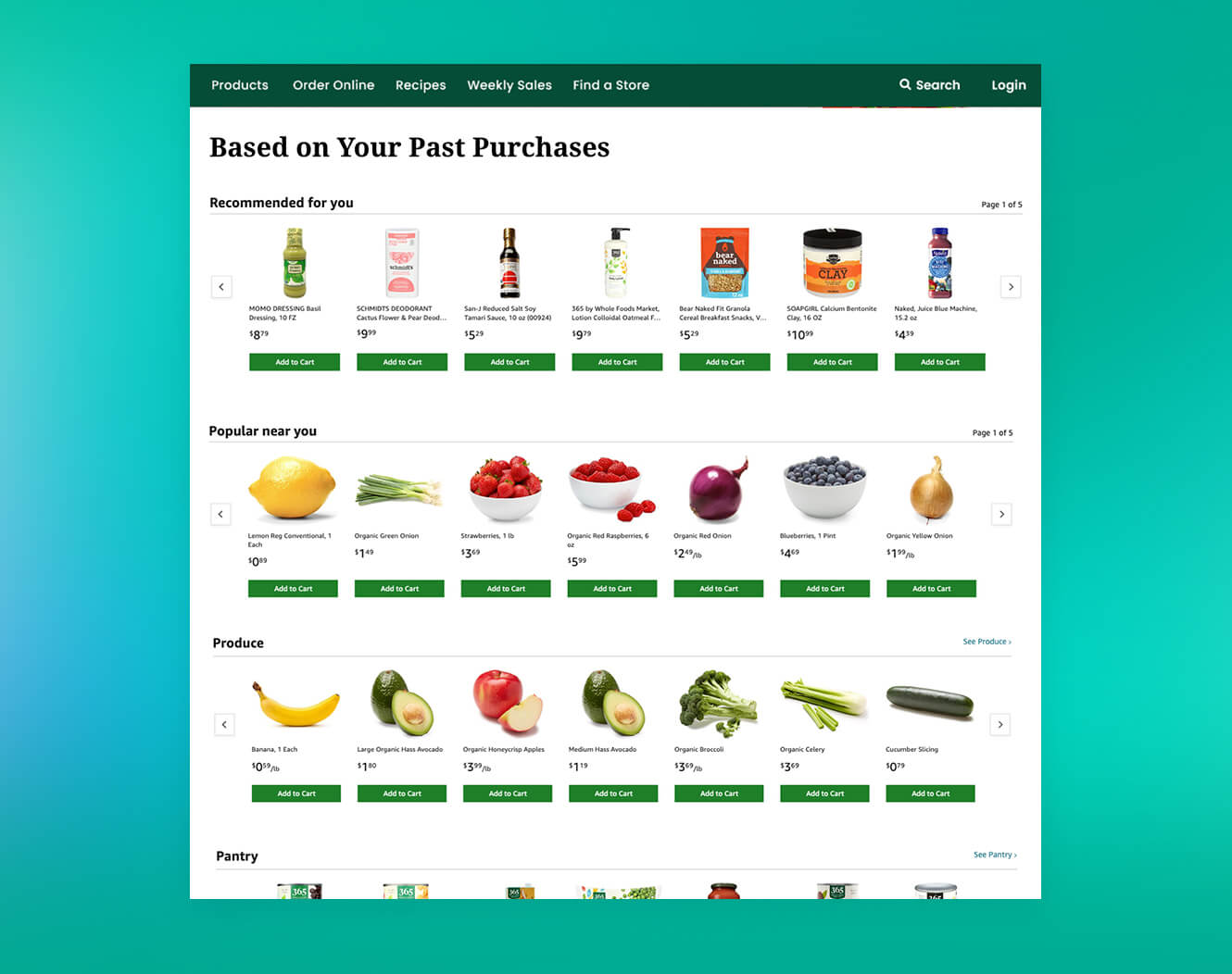5 Personalization Strategies to Bring the Magic of the In-Store Grocery Experience, Online
A subset of readily-available, specially-tailored strategies to help grocery/CPG brands acquire and convert digital customers—plus help them stay loyal.
Summarize this articleHere’s what you need to know:
- Grocery stores can personalize the shopping experience to boost customer acquisition, conversion, and loyalty.
- Recommend new products based on customers’ past purchases and browsing behavior, similar to in-store discovery.
- Personalize homepage and product recommendations to cater to individual dietary restrictions and preferences.
- Offer shoppable recipes and 1:1 email marketing based on purchase history and affinity profiles to enhance engagement.
- By implementing these strategies, grocery stores can foster stronger customer relationships and drive revenue growth.
Although consumers have come to love curbside pick-up and online grocery shopping, these options don’t naturally instigate the magic of product discovery like an in-store experience could. While initial optimizations, like “quick reorders” and “favorites,” have helped convert some skeptical online shoppers to loyal weekly orderers, these one-size-fits-all interactions can still alienate consumers looking for more personalized experiences and keep eCommerce grocery brands from seizing expanded revenue potential.
But with the onset of new comprehensive technologies that help overcome historic barriers like large, unwieldy inventory and lackluster digital infrastructure, grocery teams can better cater to their customer’s unique needs. All they need to know now are the right types of personalization to employ.
Below, find five high-impact personalization strategies designed to help grocery stores improve customer acquisition, conversions, and long-term loyalty.
1. Encourage new product discovery in an intuitive way
Many enjoy the thrill of browsing the aisles and discovering an unexpected or intriguing product. But this experience hasn’t been naturally replicated online, due to the numerous product attributes associated with each grocery item, such as dietary, culinary, and ingredient nuances. Despite this, grocery teams can still encourage new product discovery in ways that parallel—or even improve upon—the in-person experience through the effective implementation of product recommendation widgets.
For starters, a widget can be placed on the homepage of a site or mobile app which leverages an affinity algorithm to recommend both items the shopper previously bought as well as items that they haven’t yet tried—replicating the experience of seeing a similar product next to a favorite on the shelf or noticing another shopper reaching for a new brand in the same aisle. In practice, say a user has shown an affinity for coffee, buying a carton of iced coffee in the past. The recommendation widget can display discovery items like single-serve iced coffees as well.

Grocery teams can also replicate promotional displays, like those on an aisle’s end cap, on their digital properties—with an added layer of personalization. Say a shopper has an affinity for higher-end toiletries and decadent ice cream treats: A recommendation widget placed on the homepage can show only relevant private label and sponsored products in these categories.

2. Reflect the shopper’s dietary restrictions and preferences
Online grocery brands can create a personalized customer experience for those shopping with strict dietary restrictions (or even just those with preferences). One that far surpasses the limited selection available in a single aisle of a physical store. The homepage can display only product recommendations personalized for a user’s unique affinities, whether using data compiled from purchase history, aggregated from similar profiles, or a combination.
For example, let’s say someone who follows an organic vegetarian diet with a noted preference for fresh products logs on the week of the Fourth of July. Rather than serve a banner campaign featuring meat-forward barbecue options—what a one-size-fits-all popularity algorithm would recommend—the affinity-based experience can instead feature seasonal produce. And, with localized stock functionality, you’ll only recommend items that are in-stock for a given location.

Additionally, widgets placed on any quick shop page (like cart or reorder) can complement in-cart items with recommendations filtered according to a user’s affinity profile. So if a gluten-free shopper starts adding baking ingredients to their cart, rather than recommending flour or other popular gluten-containing ingredients, they’ll only see gluten-free products.

3. Simplify repurchasing based on order history
Quick reorder functionality has become a helpful tool for shoppers, as they tend to buy the same basic staples with every purchase—but most don’t buy the same exact cart week after week. Shoppers often have an appetite for discovering new items, making small splurges, and rewarding themselves with special treats.
Digital grocers can capitalize on these revenue opportunities with a “just for you” page for returning shoppers, where they can feature recently purchased items, brands and produce, as well as a widget(s) that recommends products based on each user’s shopping behavior and dietary preferences.

4. Offer shoppable recipes to increase basket size
A lot of shoppers also like to simplify their grocery shopping with recipes, enjoying the structure and convenience it adds to meal planning. Grocers, too, enjoy the fact that staying close to a recipe can guarantee a higher basket size than a la carte shopping. Digital grocery teams can offer ease to shoppers—as well as open additional revenue streams for themselves—with shoppable recipes. Complete with a list of relevant products and an easy add-to-cart option, personalization based on brand affinity and other preferences (i.e. organic over conventional) can be layered on to further filter relevant products, which ends up being a marketing recipe for increased average order value.

5. Inspire future orders with personalized emails
While many shoppers order weekly, digital grocers can use the other six weekdays to capture attention, influence brand affinity, and improve loyalty. Rather than send a one-size-fits-all email to their customer base, effective email personalization can be implemented to include different promotions, content, and recommendation experiences to customers based on their past purchase history and affinity profile. And the right personalization platform can connect to your ESP and accomplish this all within the same email, without the rigidity and manual customer segmentation work.
For example, for a customer who has shown interest in barbecue products, an email experience could include a top recipe banner, as well as a collection of game day grilling, easy entertaining recommendations, and local brews. Other customers would receive the same experience, but it would be automatically modified to match their affinities. For example, if a customer has never bought alcohol but instead regularly repurchases sparkling water, a local brews feature can be swapped out for one that features best-selling seltzers.

The grocery personalization promise, delivered
The best part? Grocery and CPG marketers can implement each of these personalization strategies in their pick-up and delivery options today. Coupled with the right technology, organizations eager to replicate the in-store customer experience online will be the first to reap the benefits, watching as their investments in loyalty and revenue appreciate over time.
P.S. Learn more about how our experts can help you navigate some of these exciting Grocery-specific personalization capabilities here.

 How Deep Learning is Adding Predictive Personalization Prowess to User Affinity Profiling
How Deep Learning is Adding Predictive Personalization Prowess to User Affinity Profiling

